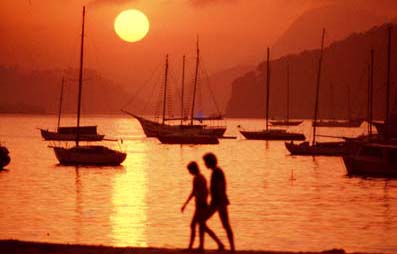
Sunrise at Botafogo marina |
This is the Sugar Loaf mountain and the Guanabara Bay, the most famous view from Rio. Even those who have been in many different places in the world use to agree about one thing. It is not easy to find another place where nature was so generous. The nature blend you find here, a one of a kind mixture of imposing mountains surrounded by the rich green foliage of tropical trees, blue skies reflected in warm waters surrounded by white sand beaches, all this framed in a climate that is the best thing next to paradise. No wonder that a popular joke in Rio says that the winter here use to be very strong indeed, and reminds visitors that last year it started on a Tuesday and ended on the following Wednesday…. |
Rio is divided into Zona Sul (south zone), Norte (north), subúrbios (metro area) and Oeste (west), but the most beautiful part of the city is surely the south zone, and logically most of the tourists prefer to stay here, mainly in Ipanema, Copacabana or Leblon quarters. Other options, with cheaper hotels but also ok, would be Barra, Urca, Flamengo and Botafogo quarters. |
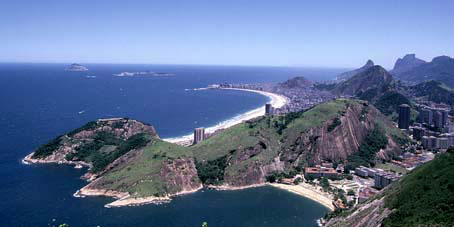
Praia Vermelha (Red Beach) and Copacabana Beach |
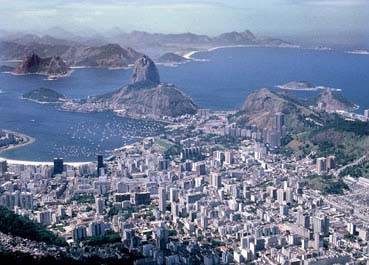
Botafogo and, at center, Sugar Loaf mountain |
Rio has two airports, Santos Dumont (domestic flights, located downtown) and Galeao/Antonio Carlos Jobim Airport (international flights). There are no subways or underground lines linking them to the rest of the city, so you will need to take a taxi or a bus. Taxis are the best option, but avoid the traditional yellow ones. It is better to get a red or blue taxi (for instance, from Transcoopass), that charge a fixed rate to take you to your hotel. They are much more comfortable and, more important, reliable. Buy the tickets according to you destination location, at the stands located at airport arrival hall. If you really prefer to save some money you can take the 'Real' blue bus, that you will take you to most destinations in South Zone. Pay the fare directly to the driver and tell him where are you going to. |
As you will see, going everywhere in Rio is easy, the city has a two lines subway system and dozens, or should I say, hundreds of bus lines. Finding the right one to take from one point to the other will be the hardest part. Don't expect to get much information or detailed maps at bus stops or anything like that. Before leaving, ask at your hotel concierge the best way to get to your destination. The yellow taxis are also everywhere, and for short distances they are a good choice. If you get a taxi, you are supposed to pay, at the end of the journey, the fare indicated at the meter (taximetro) located in the front, at the side of the driver. Extra volumes, like heavy luggage may have an additional cost and you may include a ten percent tip to the driver. That's all. Yellow taxis are not supposed to charge a fixed rate, and if the driver asks you that, he will be trying to cheat you. Just say no and let him go. And if you hesitate or find it difficult to find out the best way to get to your destination feel free to ask anyone, Cariocas (those who are born in Rio) are delighted to help tourists, and even if they don't speak your language, they will try to help you.
Video: Copacabana. |
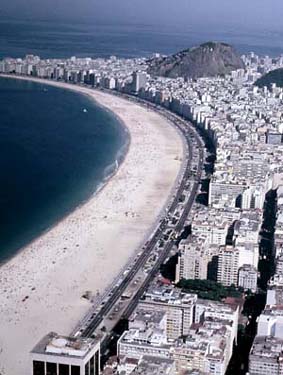
Copacabana |
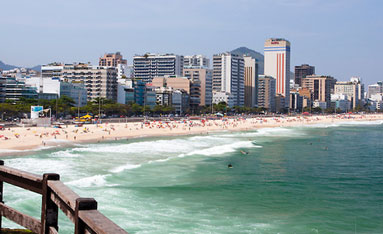
Leblon and Ipanema beaches |
Copacabana is five kilometers long and one kilometer wide, standing between the moutains and the sea. It has tree main paralels avenues: Avenida Atlântica (facing the sea, as seen above, Avenida N Senhora de Copacabana (main commercial street) and Barata Ribeiro street. There are more then a hundred hotels in Copacabana and even more bars and restaurants. Ipanema e Leblon (left photo) are less crowded than Copacabana and are a better option for those who prefer a quieter place. Here you will also find dozens of hotels, bars and restaurants, among four that you can recommend: Churrascaria Carretão (Rua Visconde de Pirajá 512), Frontera (Rua Visconde de Pirajá 128), Álvaros (Rua Cupertino Durão 500) and Degrau (Av Ataulfo de Paiva 517. |
Barra will be, according to some, what Ipanema and Leblon are now. The best part of town to stay at. Young people love it, with all its shoppings, beaches, bars, and say all they want is there, and there is no need to go anywhere else in Rio. The only problem is that in Barra you will need a car. Almost everything here is far, you can't just walk to any place. If you don't drive in Rio or won't have a driver at your disposal, we would suggest not to book a hotel here. Barra is a great place to go shopping, and you shold visit some os the best malls in Rio, likeBarra Shopping, Via Parque and Village Mall |
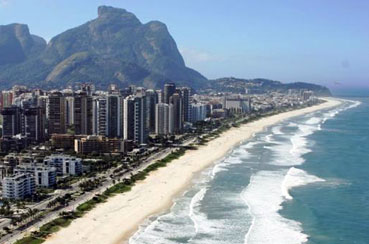
Barra da Tijuca beach |
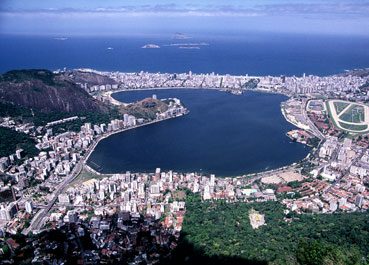
Rodrigo de Freitas Lake seen from the Corcovado mountain |
At left, Lagoa Rodrigo de Freitas, as seen from Christ the Redeemer statue. |
Cristo Redentor Monument, situated at Corcovado Mountain top, is Rio's main touristic icon. Is stands 709 meters high above sea level, and the best way to get up there in getting onboard the red train that departs from Cosme Velho station, just in front of Sao Judas Tadeu Church. The ride uphill is a lovely trip, surrounded by the so called Atlantic Forest.
Turistic Train website:
trenzinho turístico |
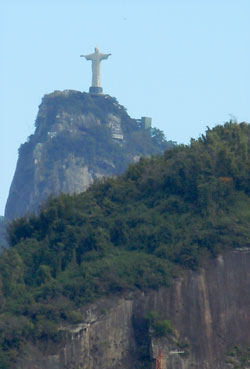
Christ the Redeemer statue,
seen from Aterro Park |
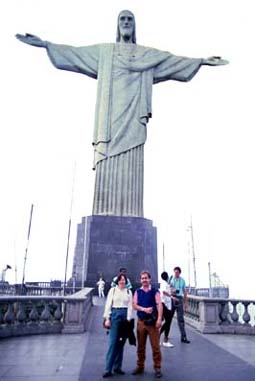
Christ the Redeemer statue |
The first Corcovado railroad was built in 1906, and it was the first to be totally electrified in Brazil, along its four kilometers. The monument itself started being built in 1922, and were open to public in 1931. It is thirty meters high, and inside its base a small chapel, dedicated to Saint Mary, was built. From this point a gorgeous view of Rio and surrounding areas can be apreciated. Try to go there on a clear day.
|
| Sugar Loaf mountain is the most important Rio tourist attraction, after Corcovado. To get at the top you will need to get a cable car, which departs from Urca. It is a two legs journey, the first one from Praia Vermelha station to Morro da Urca, where you get onboard the second cable car, and this one will take to the Sugar Loaf itself, the huge rock shown at left. The mountains is 396 meters high and the first cable car to its top was built in 1912. |
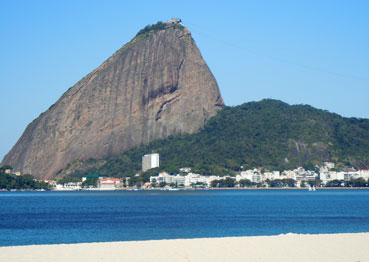
Pao de Açucar (Sugar Loaf) seen from Flamengo beach
|
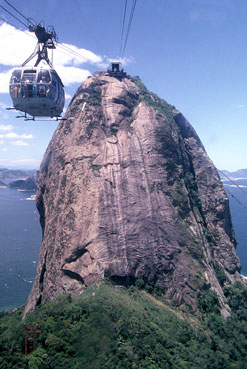
Pao de Açucar (Sugar Loaf) cable car |
Pão de Acúcar (Sugar Loaf) and its cable car. |
| Ipanema's fair is something not to be missed. Every Sunday, the best place in town to find gifts, souvenirs, leather, paintings, handcrafts and much more. Located at Praça General Osorio, next to Ipanema subway station, line one. |
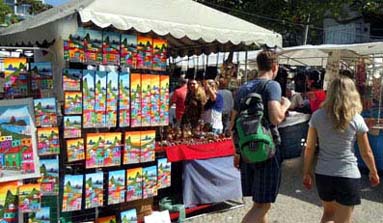
Ipanema Hippie Fair, on sundays
|
A taste of 19th century Rio and at the same a fine selection of pastries, cakes and teas, Confeitaria Colombo is a must among locals and tourists. Since 1894 is a well known address in Rio for an afternoon tea. Located downtown, close to Carioca subway station, at Goncalves Dias street. website: Confeitaria Colombo
Try also Confeitaria Cavé, at Rua 7 de setembro 137, a traditional Rio tea room from the last century, which had to move to its new location, but preserves the traditional delicious recipes. |
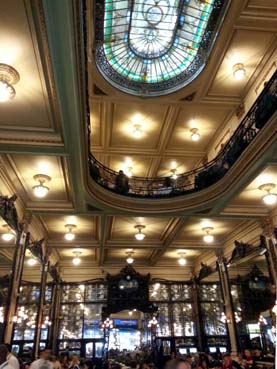
Confeitaria Colombo (downtown) |
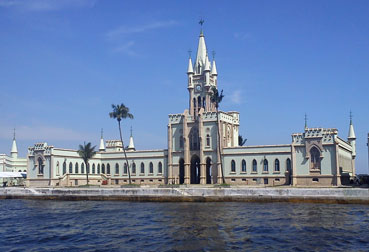
Ilha Fiscal (Fiscal Island) |
Until 1922, Ilha Fiscal belonged to Brazil Emperor. When republic came, the royal family left the country and, together will all their palaces and estates, it became a public attraction. To get there go to Praça 15 (downtown) and head to Espaço Cultural da Marinha, where a boat take visitors to the island. It is an interesting visit and tells part of the country story. |
Lovely and quiet Urca is one of the most pleasant places to live in Rio. Standing at the footsteps of Sugar Loaf Mountain, its narrow streets and traditional mansions remind us maybe a quiet town deep in the heart of the country. It is the absolute opposite from crazy Copacabana. At sunset, having a beer with some pasteis (fried paste stuffed with melted cheese), standing by its brick wall by the trees is a must among cariocas. |
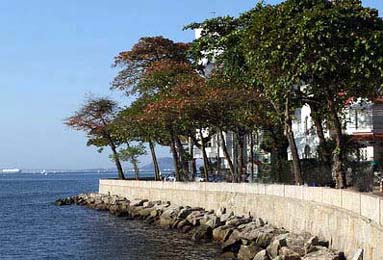
Urca Quarter
|
Monumento aos Pracinhas, located just five minutes walk from Modern Art Museum, honors those who lost their lives during Word War II.
|
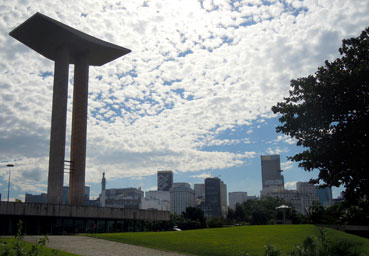
WW II heroes Momorial |
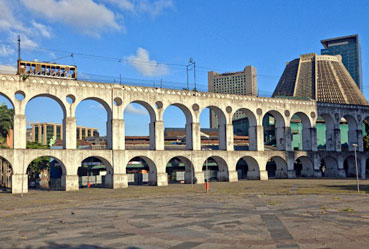
Arcos da Lapa (Lapa Arches) |
Aqueduto da Carioca, built in 1750, is one of the most well know city and Lapa neighborhood symbols. Lapa itself, is a bohemian quarter, filled with bars, traditional restaurants and live music pubs. At night, is one of the best places to go at night, especially for young people looking for some fun and some bier. Try Bar Luiz (Rua da Carioca 39), Bar Brasil (Mem de Sá 90) or Nova Capela (Mem de Sá 96) |
Nossa Senhora da Gloria do Outeiro Church, or simply Igreja da Gloria. Small, but undoubtly the most famous in town, it was built by the Portuguese settlers in 1714, and was often attended by the royal family. Today is considered a baroque piece of art and one of the best landmarks of Brazil colonial times. Next subway station: Gloria.
|
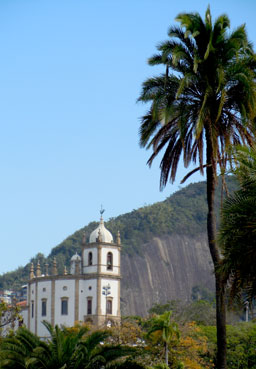
Gloria Church |
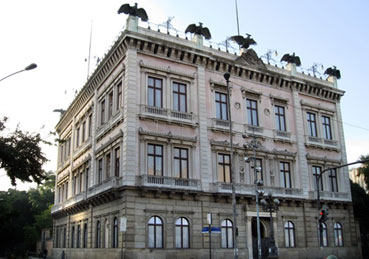
Museu da República (Former Presidential Palace) |
Former presidential palace Palacio do Catete (Catete Palace) now houses Museu da República (Republic Museum), but until the country capital city moved to Brasilia, in 1960, this was Brazil main office. Here, in a huge political crisis, president Getulio Vargas killed himself, avoiding before being impeached. The museum has very interesting expositions about that time. Visit also the beatiful gardens. Nearest subway station: Catete |
| Santa Teresa, considered by some as Paris Montmartre or San Francisco California in Rio is located up in the city hills, and is the only part of town where you can still find the traditional cable cars. Mild temperatures, good restaurants and bars, cozy hostels, make this part of Rio a preferential place among young tourists looking for something different than just beaches. |
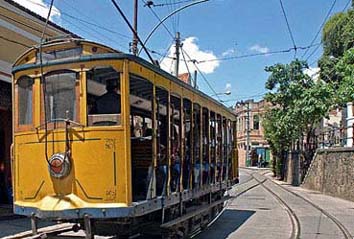
Santa Teresa Quarter
|
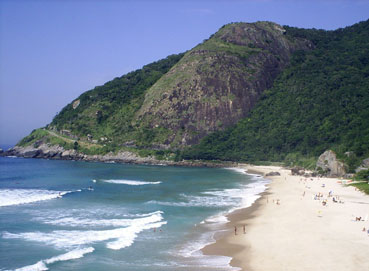
Grumari Beach |
Grumari Beach remains as it always was. Clear water with green trees and mountains all around. As a nature preserved area, nothing can be built here, so you will feel as if you were, let's say, in a tropical island, way from everything. Actually you will, in fact, be far, because Grumari is located something like twenty kilometers from Barra da Tijuca, but if you have a car, it is really worth visiting this place. Try to visit also Prainha beach, next to it |
|
Ipanema and Leblon quarters are considered the best and most fashionable neighborhoods in Rio. No wonder apartments rental prices here are high. Anyway, walking along its main avenues and streets costs nothing, and you wouldn't want to miss it. Take, for instance, Vieira Souto, facing the sea, all the way down. Then go back following Delfim Moreira (Leblon) and Visconde de Pirajá (Ipanema). Along this streets you will find a lot of bars, cafes, bookstores, restaurants and fashionable boutiques. Visit also Shopping Leblon (290 Afranio de Melo Franco ave), one of the best malls around. |
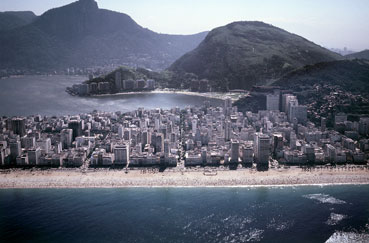
Ipanema and Lagoa Quarters |
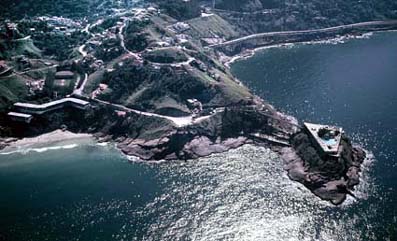
Joa and Joatinga quarters seen from the air
|
Joa or Joatinga neighborhood, considered by many as Rio's Beverly Hills. Luxury mansions, impressive architecture homes, and no one You will need a car to get there, but the sea and mountains view from here is probably second to none. |
One of the best preserved parts of colonial Rio can be found next to Praça 15 Square, downtown, very close to the former city harbor. Here the imperial Portuguese family arrived, escaping from Napoleon wars in Europe, and here they built their first palace. Luckily many buildings and landmarks survived and can still be seen, now hosting bars and restaurants. Beautiful Arco do Teles (Teles Arch), is located on the main entrance gateway. |
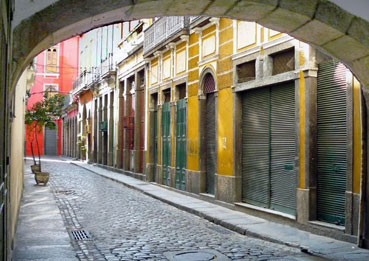
Travessa do Comércio and Arco do Teles (old Rio)
|
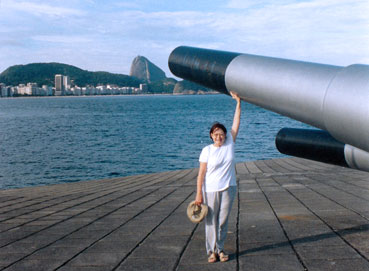
Copacabana Old Fort and the Sugar Loaf
|
Old Forte de Copacabana (Copacabana Fort) construction started in 1769, when the Portuguese felt the needed something to keep Spanish and French combat ships way from Rio. Its giant guns don't make any noise any more, but, on the other hand, you still find there an army museum and, even better, a Confeitaria Colombo patisserie, where you can have a tea facing the sea and Copacabana Beach. Its the perfect location for an afternoon lunch. |
Thinking about Rio is thinking about Carnaval. During the four days of Carnaval, Rio turns itself into rhythm, samba parades, crazy costumes and funny nonsense. There are many events in town during Carnaval, like costume contests, Carnaval balls, groups of samba players and rythmists parading in the streets at any time of day, gay balls, but the most important event is surely the Desfile das Escolas de Samba (Samba schools parade). Each one of them use to bring more than three thousand people.
According to the rules, each Samba School have about 80 minutes to tell an original story (the Enredo) which may be anything, but must be told in the rhythm of samba. Costumes, songs, musicians, lyrics, choreography, everything must be related to the chosen Enredo. When Carnaval is over, a jury of samba experts elects the winners of each category, the best costumes, best samba song, best Enredo, etc, including the great winner of them all: the best Samba School of the year. The following Saturday, the best five samba schools can be seen parading again at the same place. And in case you would like to take part in the great samba parade it’s easy. All you need to do is contact any of the major samba schools and buy a costume. Ask your hotel concierge for details. |
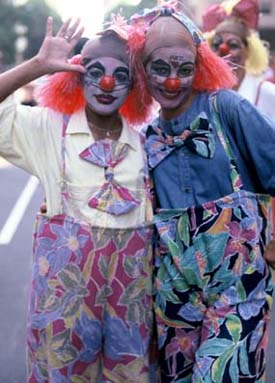
Carnaval time in Rio
|
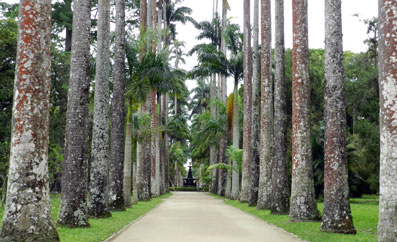
Jardim Botânico (Botanic Gardens)
|
A must for tourist is a visit to Rio Botanical Garden. More the seven thousand different species from around the world, the Jardim Botânico was founded by Portuguese emperor Dom João VI, in the early eighteenth century. |
New year’s eve is also one of the greatest events of the year in Rio and the right place to be is Copacabana, where many streets are even closed to traffic, so crowded it gets. Do like the Brazilians, and dress in white to bring good luck to the next year. Go to the shoreline and throw some flowers in the ocean as an offer to Iemanja, the ancient goddess of the oceans. Dance and enjoy yourself all night long at one of the many samba and Brazilian music shows at the beach stages, and at midnight watch the skies for a 20 minutes firework show that you’ll probably never forget. But don’t think its over. Stay there and wait for dawn.
Watching the sun rising at the sea on the first day of the year is an unforgettable experience, and if, after all that, you feel hungry, just cross the street back to any of the many hotels in front of the sea and try their delicious first-day-of- the-year brunches. We bet new years eve at Rio will be the experience of a lifetime. We will also be there, and, who knows, we may even meet at the sands of Copacabana… |
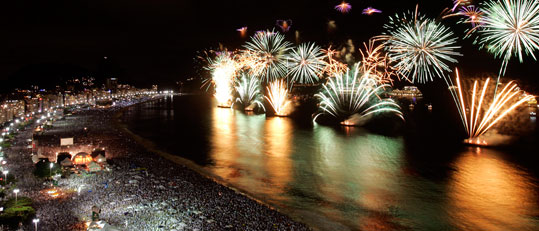
Copacabana Beach New Year's Eve Fireworks |
Videos: Taking off from Rio - Copacabana New Year's Eve Fireworks
|
|